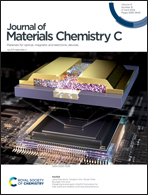Promoting photoreduction selectivity via synergetic utilization between vacancy and nanofiber structure over flexible Zr/TiO2−x nanofiber films†
Abstract
Photocatalytic conversion of CO2 into value-added hydrocarbon fuels is a promising approach to alleviate the energy crisis caused by the overuse of fossil fuels. Here, a flexible Zr/TiO2−x nanofiber photocatalyst with abundant oxygen-vacancies (OVs) has been fabricated and employed in the CO2 photocatalytic reduction process. The selectivity for the photocatalytic reduction of CO2 to CH4 over H400-Zr/TiO2−x nanofiber films could reach up to 87.6% which is rather high compared with currently reported photocatalytic systems. In-depth experiments demonstrate that the high product selectivity of CH4 originated from the synergetic effect between vacancy and nanofiber structure in H400-Zr/TiO2−x. Density functional theory (DFT) simulation reveals that the existence of a vacancy in H400-Zr/TiO2−x facilitates a reduction in the surface free energy barrier from the intermediate CO* to CHO* during the production of CH4, which is further confirmed by the observed obvious CHO* signal in in situ FTIR spectra. Additionally, the characteristic of one-dimensional long-range orientation and large surface area of nanofiber structure of H400-Zr/TiO2−x is beneficial to providing more catalytic active sites which help to promote the CO2 photoreduction property. This work paves the way for the efficient design of photocatalytic systems towards high conversion of CO2 to CH4.

- This article is part of the themed collection: Journal of Materials Chemistry C Emerging Investigators 2024


 Please wait while we load your content...
Please wait while we load your content...